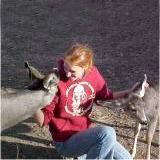Professional summary
Kate's research focuses on the effects of environmental change on wildlife behaviour, populations and distributions. By combining contemporary ecological techniques with an understanding of species interactions and dynamics in heterogeneous environments, she aims to gain mechanistic, process-driven understanding of ecological systems through both statistical modelling and more applied, management-orientated experiments. Kate is particularly interested in methods for scaling up from the mechanisms underlying individual behaviour of wildlife to understand and predict population and ecosystem level consequences in rapidly changing complex environments.
Currently she is working to understand how extrinsic — climate change, fisheries, marine renewable energy developments — and intrinsic — density dependence — processes drive the distribution, abundance, behaviour and population dynamics of seabird species.
Searle KR, CE Regan, MR Perrow, A Butler, A Rindorf, MP Harris, MA Newell, S Wanless & F Daunt. 2023. Effects of a fishery closure and prey abundance on seabird diet and breeding success: implications for strategic fisheries management and seabird conservation. Biological Conservation(281)109990,ISSN:0006-3207, https://doi.org/10.1016/j.biocon.2023.109990. (https://www.sciencedirect.com/science/article/pii/S0006320723000903).
Broughton RK, KR Searle, LA Walker, ED Potter, MG Pereira, H Carter, D Sleep, DG Noble, A Butler, & AC Johnson. 2022. Long-term trends of second generation anticoagulant rodenticides (SGARs) show widespread contamination of a bird-eating predator, the Eurasian Sparrowhawk (Accipiter nisus) in Britain. Environmental Pollution 314, 120269.
Bennett S, MP Harris, S Wanless, JA Green, MA Newell, KR Searle & F Daunt. 2022. Earlier and more frequent occupation of breeding sites during the non‐breeding season increases breeding success in a colonial seabird. Ecology and Evolution 12 (9), e9213
Willsteed, E., New, L., Ansong, J., Hin, V., Searle, K.R., & A. Cook. 2023. Advances in cumulative effects assessment and application in marine and coastal management. Cambridge Prisms: Coastal Futures, 1, E18. doi:10.1017/cft.2023.6
Searle KR, SH O’Brien, EL Jones, ASCP Cook, MN Trinder, RM McGregor, C Donovan, A McCluskie, F Daunt & A Butler. 2023. A framework for improving treatment of uncertainty in offshore wind assessments for protected marine birds. ICES Journal of Marine Science 2023;, fsad025, https://doi.org/10.1093/icesjms/fsad025.
Croll DA, AA Ellis, J Adams, ASCP Cook, S Garthe, MW Goodale, CS Hall, E Hazen, BS Keitt, EC Kelsey, JB Leirness, DE Lyons, MW McKown, A Potiek, KR Searle, FH Soudijn, RC Rockwood, BR Tershy, M Tinker, EA VanderWerf, KA Williams, L Young & K Zilliacus. 2022. Framework for assessing and mitigating the impacts of offshore wind energy development on marine birds. Biological Conservation 276, 109795.
Searle KR, A Butler, JJ Waggitt, PGH Evans, MI Bogdanova, NT Hobbs, F Daunt & S Wanless. 2022. Opposing effects of spatiotemporal variation in resources and temporal variation in climate on density dependent population growth in seabirds. Journal of Animal Ecology 91(12): 2384-2399.
Searle KR, A Butler, JJ Waggitt, PGH Evans, LR Quinn, MI Bogdanova, TJ Evans, JE Braithwaite & F Daunt. 2022. Potential climate-driven changes to seabird demography: implications for assessments of marine renewable energy development. Marine Ecology Progress Series 690, 185-200
Young, J. C., K. Searle, A. Butler, P. Simmons, A. D. Watt, and A. Jordan. 2016. The role of trust in the resolution of conservation conflicts. Biological Conservation 195:196-202.
Searle, K. R., M. B. Rice, C. R. Anderson, C. Bishop, and N. T. Hobbs. 2015. Asynchronous vegetation phenology enhances winter body condition of a large mobile herbivore. Oecologia 179:377-391.
